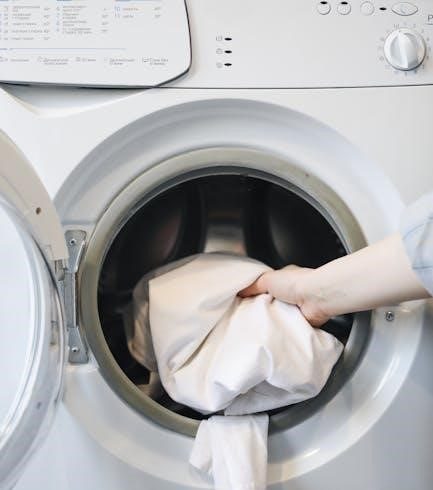The Manual Swapped Crown Victoria has gained popularity among enthusiasts as a unique project car, combining classic styling with modern drivetrain modifications for enhanced performance and driver engagement.
1.1. Overview of the Manual Swap Trend
The trend of manual swapping Crown Victorias has grown among enthusiasts seeking better performance and driver engagement. The TR3650 transmission, commonly sourced from Mustangs, is a popular choice due to its durability and affordability. This modification allows owners to transform their Crown Vic into a more responsive and fun-to-drive vehicle, appealing to those who value a hands-on driving experience and unique customization.
1.2; Benefits of Converting to a Manual Transmission
Converting a Crown Victoria to a manual transmission offers several advantages, including improved fuel efficiency, better control, and a more engaging driving experience. It also reduces reliance on automatic systems, potentially lowering maintenance costs. Enthusiasts appreciate the enhanced performance and the ability to customize their vehicle, making it a rewarding project for those seeking a unique and personalized ride.

Brief History of the Ford Crown Victoria
The Ford Crown Victoria, introduced in 1992, became renowned for its durability and spaciousness. It served as a popular police interceptor before its discontinuation in 2011.
2.1. Origins and Evolution of the Crown Victoria
The Ford Crown Victoria originated as a full-size sedan in 1955, evolving over decades. By 1992, it became a staple for police and taxi fleets, known for its Panther platform. The Crown Vic’s robust design and V8 power made it a favorite for law enforcement, with continuous updates improving reliability and performance through its production run until 2011.
2.2. Popularity and Use Cases for Crown Victoria
The Crown Victoria gained prominence as a police interceptor and taxi vehicle due to its durability and powerful V8 engine. Its affordability and reliability made it a favorite for fleets. Enthusiasts appreciate its spacious interior and retro styling, often seeking it for manual swaps to enhance performance and driving engagement, blending practicality with customization.

Planning the Manual Swap
Planning a manual swap requires choosing the right transmission, such as the TR3650, and budgeting for necessary parts and modifications to ensure compatibility and smooth operation.
3.1. Choosing the Right Transmission (e.g., TR3650)
The TR3650 transmission, commonly found in 2001-2010 Mustangs, is a popular choice for Crown Vic manual swaps due to its durability and affordability. This 5-speed manual transmission is well-suited for the Crown Vic’s engine, offering a balance of performance and reliability. Its widespread availability makes it a cost-effective option for enthusiasts seeking a robust drivetrain upgrade.
3.2. Budgeting and Parts Acquisition
Budgeting for a Crown Vic manual swap requires careful planning, as costs can vary widely depending on the transmission and additional components needed. The TR3650 transmission is a cost-effective option, often sourced from Mustangs, while other parts like clutch kits and shifters add to the total. Acquiring parts from salvage yards or online forums can help reduce expenses, making the project more accessible for enthusiasts.

Key Modifications Required
Converting a Crown Victoria to manual involves essential modifications, including engine compatibility adjustments, clutch and pedal installations, and wiring changes to ensure smooth operation of the new transmission.
4.1. Engine and ECU Compatibility
Ensuring engine compatibility with the manual transmission is crucial. The ECU must be reprogrammed or replaced to eliminate automatic transmission dependencies. Many enthusiasts opt for ECU swaps from Mustangs, which share similar engines, to maintain functionality. Additionally, the TR3650 transmission requires specific tuning to work seamlessly with the Crown Victoria’s engine, ensuring optimal performance and reliability.
4.2. Clutch and Pedal Setup
Installing a clutch and pedal assembly is essential for manual operation. The McLeod street clutch is a popular choice for its durability and smooth engagement. Additionally, components like the FRPP shift fork and throw-out bearing are often recommended for reliability. Proper alignment and spacing of the clutch pedal are critical to ensure smooth shifting and prevent mechanical issues during driving.

Wiring and Harness Considerations
Replacing the PCM with one from a manual-transmission Mustang is often necessary to trick the computer. Rewiring the harness to accommodate manual operation is also crucial for proper functionality.
5.1. Rewiring for Manual Transmission
Replacing the PCM with one from a manual-transmission Mustang is often necessary to trick the computer. Rewiring the harness to accommodate manual operation is also crucial for proper functionality.
5.2. Integrating Aftermarket Components
Aftermarket components like shifters and gauges enhance the driving experience. Adapters and custom wiring ensure compatibility, while speedometer recalibration is essential for accurate readings. These upgrades streamline the swap process.
Driveshaft and Suspension Adjustments
A manual swap requires replacing the driveshaft for proper length and balance. Suspension modifications may include upgraded bushings and springs to optimize handling and stability post-conversion.
6.1. Driveshaft Replacement and Balancing
Replacing the driveshaft is crucial for a manual swap. The automatic transmission driveshaft must be swapped with a shorter manual-specific one to ensure proper fitment and avoid vibration. Balancing the new driveshaft is essential for smooth operation and to prevent damage to the transmission and differential. This step requires precision to maintain optimal performance and reliability over time.
6.2. Suspension Modifications for Manual Swap
Suspension modifications are necessary to accommodate the manual transmission’s weight distribution and ensure proper alignment. Upgrading components like leaf springs, coilovers, and the Panhard rod helps maintain stability. Rear suspension adjustments, including shackles and bushings, are often required to align the axle correctly. These modifications enhance handling and prevent uneven tire wear, ensuring a smooth and responsive driving experience with the manual setup.

Brake System Modifications
Upgrading the master cylinder and brake lines improves stopping power. The parking brake may require modification to function properly with the manual transmission setup.
7.1. Master Cylinder and Brake Line Upgrades
Upgrading the master cylinder is essential for a manual swap, as it ensures proper brake pressure without interference from the automatic transmission. High-performance brake lines are often installed to reduce fluid pressure loss, enhancing braking efficiency. These modifications are crucial for maintaining reliable stopping power in a manual-swapped Crown Victoria, especially under spirited driving conditions.
7;2. Addressing Brake Cancelation Issues
Brake cancelation issues arise when the PCM misinterprets manual transmission inputs, causing unintended engine stalls. Solutions involve reprogramming the PCM to disable automatic transmission-specific codes or installing aftermarket modules that mimic manual transmission signals. This ensures smooth operation and prevents sudden stalls, making the Crown Vic more reliable and safer to drive in manual configuration.

Tuning and PCM Configuration
Tuning the PCM is essential for manual operation, requiring specific calibration to disable automatic transmission codes. Using tools like HP Tuners ensures proper engine performance and prevents issues like incorrect fuel trims.
8.1. Flashing the PCM for Manual Operation
Flashing the PCM with a manual-specific calibration is crucial to eliminate automatic transmission dependencies. This involves using tools like HP Tuners to rewrite the engine’s software, ensuring compatibility with the manual transmission. The process disables features tied to automatic operation, such as torque converter controls, and recalibrates engine parameters for smooth manual shifting and optimal performance. Proper flashing prevents stalling issues and ensures reliable operation.
8.2. Tuning Strategies for Optimal Performance
Post-swap tuning requires precise calibration of fuel injection, ignition timing, and torque curves to maximize engine efficiency. Utilizing tools like HP Tuners or SCT, enthusiasts can refine the ECU for manual operation, enhancing throttle response and power delivery. Adjustments to clutch engagement and shift points further optimize the driving experience, ensuring the Crown Vic delivers both performance and reliability as a daily driver.
Cost and Reliability Considerations
The manual swapped Crown Victoria offers a budget-friendly option for enthusiasts, with total costs often under $5,000. Reliability remains strong due to the Crown Vic’s durable design and parts availability, making it a practical choice for daily driving despite the swap.
9.1. Total Cost of the Manual Swap
The total cost of a manual swap for a Crown Victoria can range from $3,000 to $6,000, depending on the transmission choice and condition. A used TR3650 from a Mustang often costs between $1,500 to $3,000. Additional expenses include a clutch kit, driveshaft, and potential PCM reprogramming, making it a cost-effective modification compared to buying a standalone performance vehicle.
9.2. Long-Term Reliability and Maintenance
A well-executed manual swap can enhance the Crown Victoria’s long-term reliability, especially with robust transmissions like the TR3650. Regular maintenance, such as clutch replacements and driveshaft inspections, is essential. The Ford Panther platform’s proven durability further supports its reliability as a daily driver, making it a practical choice for enthusiasts seeking a balance of performance and dependability.

Common Issues and Troubleshooting
Common issues post-swap include engine stalling, wiring harness incompatibility, and brake cancellation problems. Reusing Crown Vic parts and addressing PCM configurations often resolve these concerns effectively.
10.1. Typical Problems Encountered Post-Swap
Post-swap issues often include engine stalling, incorrect gear engagement, and wiring harness incompatibility. The PCM may send conflicting signals, while the TCM can malfunction. Brake systems may also require recalibration to function properly.
10.2. Solutions and DIY Fixes
Solutions include reflashing the PCM with a manual transmission tune and ensuring proper wiring connections. DIY fixes involve adjusting clutch pedals, replacing faulty sensors, and recalibrating brake systems. Online forums and community guides provide detailed steps for resolving common issues, enabling enthusiasts to troubleshoot effectively and maintain their manual-swapped Crown Victoria’s performance and reliability.

Community Support and Resources
Enthusiasts rely on forums like CrownVic.net and social media groups for advice and resources, sharing experiences, troubleshooting guides, and DIY tutorials to support manual swapped Crown Vic projects.
11.1. Online Forums and Communities
Online forums like CrownVic.net and Facebook groups dedicated to manual swapped Crown Vics offer valuable resources, technical advice, and community support. Enthusiasts share their experiences, troubleshooting tips, and DIY guides, fostering collaboration and innovation. These platforms are essential for resolving common issues and staying updated on the latest trends in manual swap projects, ensuring a smoother and more informed modification process for enthusiasts.
11.2. Recommended Tools and Documentation
Essential tools for a manual swap include a transmission jack, torque wrench, and wiring diagram for rewiring. Documentation like the Ford Crown Victoria service manual and PCM tuning guides are crucial. Additionally, tuning software such as HP Tuners or SCT is necessary for configuring the engine computer. A detailed modification guide from experienced builders can streamline the process and ensure compatibility across all components.
The manual swapped Crown Victoria offers a rewarding blend of classic style and driving engagement, with potential for future modifications and performance enhancements, making it a standout project car.
12.1. Summary of the Manual Swap Process
Converting a Crown Victoria to a manual transmission involves replacing the automatic with a compatible unit like the TR3650, modifying the wiring harness, and reprogramming the PCM. Key steps include installing a clutch pedal, adjusting the driveshaft, and addressing brake cancelation issues. Proper tuning is essential for smooth operation, and community resources often provide valuable guidance for overcoming challenges during the swap process.
12.2. Future Prospects for Manual Swapped Crown Vics
The future of manual-swapped Crown Victorias looks promising, with rising interest among enthusiasts and increasing availability of aftermarket parts. As more owners embrace the swap, the community is expected to grow, driving innovation and reducing costs. These cars may become sought-after for their unique blend of performance and affordability, making them a staple in the automotive modification scene for years to come.


